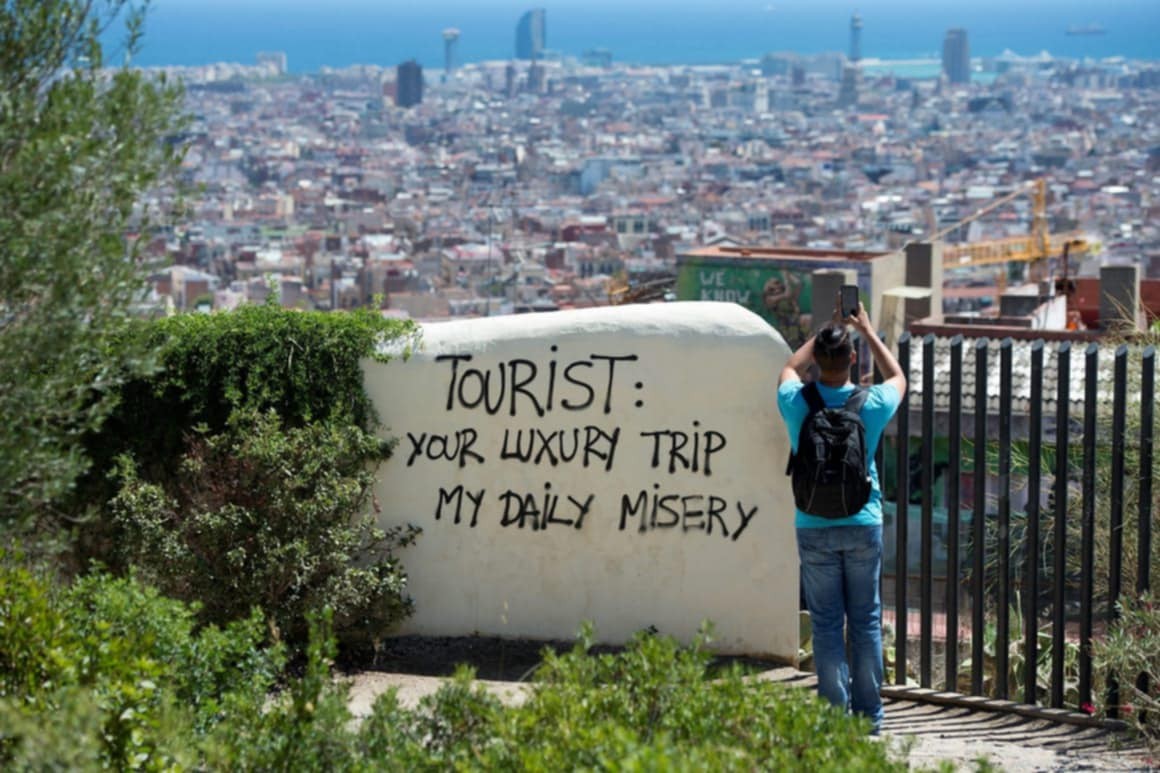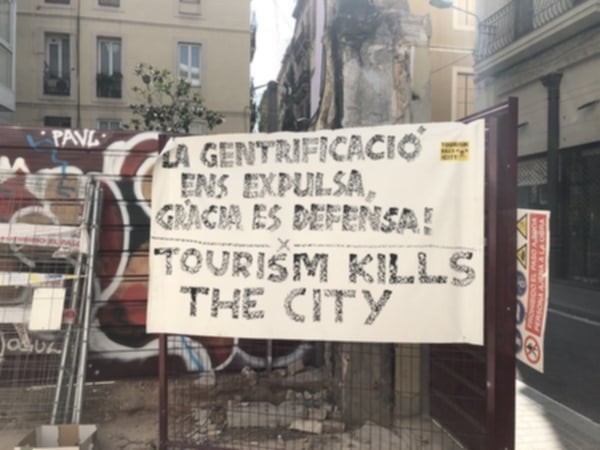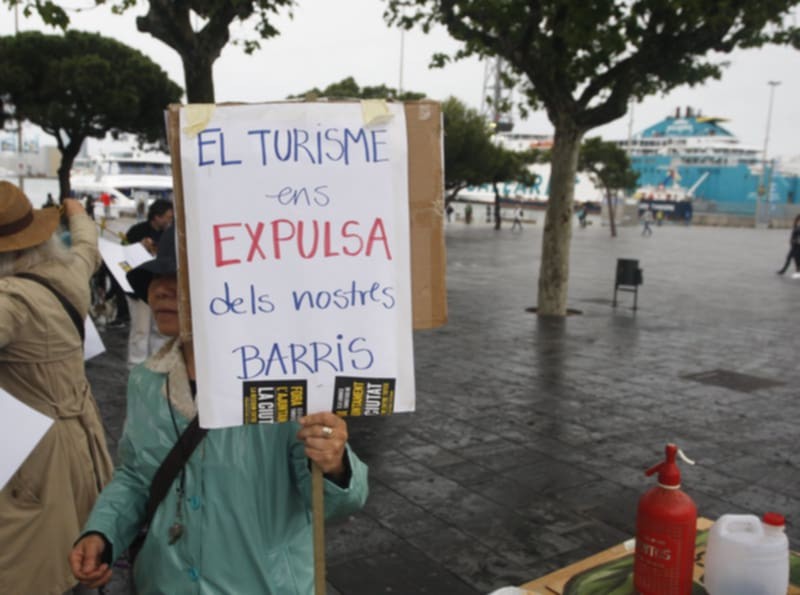By Efterpi Komninou,
Tourism inarguably has been a source of valuable income for the the countries that welcome huge numbers of tourists every year. This has led to certain economic structures that prioritize anything tourism-related as a medium for economic growth. It is a logical consequence as tourism has become a huge contributor of income and as a result there are efforts to create more and more tourist accommodations and occupations that can best serve the current economic needs. So far so good• yet, as with everything that becomes excessive, there can be severe drawbacks.
Tourism is undeniably valuable and no one would disagree on that. What happens though when tourism becomes so massive that it sort of becomes a burden?
There are numerous answers to this issue and one of these has been the “Tourism go home” movement in Spain. It is a movement that’s being carried out by locals who are suffering the collateral damages of mass tourism: unaffordable housing, unaffordable prices for goods and services, overcrowded spaces, environmental issues, noise, cultural alienation and so on.

On one hand, local inhabitants end up becoming second in this prioritization of the tourist experience and profit. A kind of injustice is clearly noticeable as they end up living in tolerance for others to live in abundance. Of course, this is no reason for being spiteful or hateful against tourists themselves although they should also become part of this awareness of the issue. The fundamental error lies in the way it is handled both in terms of law, education and economic policy.
To make an illustration out of this, most people in Spain are indirectly forced to cohabitate with one, two, or even more people just to be able to afford housing. The rise of AIRBNBs both as an alternative affordable renting choice for tourists and as a profitable means for income for owners has led to increased housing costs and unavailability of apartments for long-term renting. No to mention that a lot of the AIRBNBs are not fulfilling the conditions to be rented as such so there are a lot of them that operate unlawfully. One thing is certain: As principals of economic theory indicate when there is little availability there is more demand, and when the demand is increased so are the prices of the available apartments.
Apart from the housing industry, job prospects are also severely altered and impacted. There may be an increase in tourism-related jobs but at the same time those jobs are not paying the highest prices as the demand is so great that every worker is dispensable at the eyes of the employers. At the same time, the economic model which gives emphasis on tourism as a primary source of income ends up investing less in other important areas of activity (assisting the productive or manufacturing sector or education for instance) reducing the job prospects there too.

So what is touristification/tourism gentrification and how does it reveal itself in tourism-stricken areas?
It is exactly the consequence of the previous premises: The procedures which lead to displacement of locals from their neighborhoods due to the invasion of tourism activities and uses of land. It is namely the changes that have been imposed to different levels where short-term rentals play a crucial role in the degradation of the living standard.
What is the result of this? A generalized anger, frustration and demand for a more just treatment. Locals feel like they have had enough and have resolved in demonstrations. Tourists go home is the primary slogan of a movement which aims to raise awareness on the tourists themselves as well as the regional and local governments of the effects of mass tourism on Spain’s cities especially during holiday months. The phrase spreads throughout the city either as a public graffiti, as a poster, as a scream or as a water-gun “attack” on tourists. The phrase is certainly impactful as it is reflective of an underlined disappointment and exhaustion which becomes apparent in the daily moil of residents.
Another response to this phenomenon that should also be considered is the city’s squats which apart from being open cultural and political spaces they serve a very practical purpose too: They give shelter to those in need. People unable to pay the high prices of rent, the homeless, the refugees and even people that someone would not expect them there based on the fact that they seem to have every dot checked in the recipe of success which is proposed in the American dream. In Barcelona, it is estimated that there are more than 20,000 squats the respond to the need for shelter. Landlords sometimes use the services of private eviction companies that operate on the edge of legality to get rid of squatters. Yet this is another instance of a collision between what is lawfully right and what is ethically acceptable.
The 1995 Criminal Code among other things criminalized squatting, but failed to stop it. Social centers exist across the country and in Barcelona and Madrid in particular.
So, is there any way to regulate massive tourism? Are there measures to be taken for the phenomenon to be regulated, or is it just a case of acceptance of the so called laissez-faire of the market?

There are studies that showcase the need for developing sustainable tourism alternatives which put cultural heritage at the center of urban development and regeneration. Municipalities and local communities should advance this by being given a more central role to the design of public policy. The needs of the local community should be forwarded and taken into account in policy making. In Spain, the leftwing government has made attempts to create more housing and to regulate rents but the measures taken were insufficient due to resistance of regional governments that have refused the declaration of high-tension areas, a division which aimed to limit rent into this areas.
Another aspect for consideration should be investing in affordable infrastructure both for the benefit of residents and tourists.
Travelers should also become conscious of their choices: By learning about the housing pressures in the places they visit, by opting to stay on resort towns on the area rather than overcrowded cities, by choosing accommodation which is designed for tourists and by raising awareness themselves on these issues. A prevalent measure in Spain is that of increased taxation for tourists that visit popular destinations and accommodations. Other options including limiting cruising ships, fining for inappropriate behaviors, create walking spaces on trailed rails to prevent from more environmental damage, banning new vacation rentals when a city overflows with tourists and so on.
References
- These Countries Are Taking Extreme Action To Tackle Overtourism. Forbes. Available here
- Alternative to mass tourism? Sustainable tourism and the regulation of short-term rentals. URBACT. Available here
- As anti-tourism protests grow in Europe, we need a rethink – but that’s no reason to stop travelling. The Guardian. Available here




